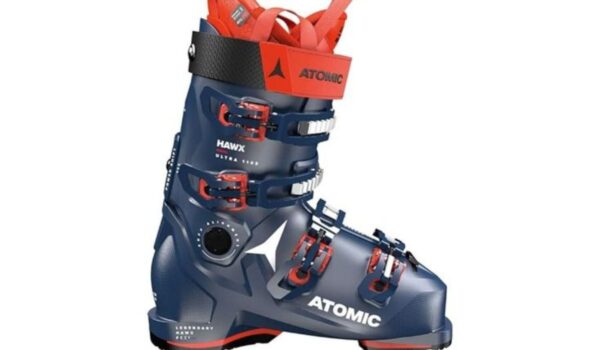
When it comes to your skiing gear, the longevity of ski boots is an important factor to consider. Ski boots are subjected to rigorous use and external conditions that can impact their durability. Understanding the average lifespan of ski boots and how to extend it through proper maintenance and care can help you make the most of your investment while ensuring optimal performance on the slopes.
According to manufacturers, ski boots should last around 200 skier days. However, the actual lifespan can be influenced by various factors. These include the use of ski boot liners, the condition of the plastic shells, and exposure to external elements like heat and sunlight. By being aware of these factors and taking appropriate measures, you can prolong the life of your ski boots and enhance your skiing experience.
Key Takeaways:
- On average, ski boots are expected to last about 200 skier days.
- Factors such as the use of ski boot liners and the condition of the plastic shells can affect the lifespan of ski boots.
- Regular maintenance and care, such as cleaning and drying the boots, can help extend their lifespan.
- Replacing worn-out liners with aftermarket options can enhance the fit and performance of ski boots.
- If your skiing ability has improved, upgrading to new boots that match your skill level is recommended.
Signs that Ski Boots Need to Be Replaced
Regularly checking your ski boots for signs of deterioration is essential to ensure optimal performance and safety on the slopes. Here are the key signs that indicate it’s time to replace your ski boots:
Worn Toe and Heel Pieces
Inspect your ski boots for visible signs of wear and tear on the toe and heel pieces. These areas are subjected to significant stress and can become worn over time. If you notice excessive wear or damage, it’s a clear indication that the boots need replacing.
Broken Plastic Shells
Examine the condition of the plastic shells, which form the outer structure of your ski boots. Cracks, fractures, or other signs of damage indicate that the integrity of the boots has been compromised. Broken plastic shells can impact your performance and may lead to safety concerns, so it’s crucial to replace your boots if you notice any such issues.
Disintegrating or Packed Out Liners
Pay attention to the liners inside your ski boots. Over time, the liners can disintegrate or pack out, causing them to lose their shape and fit. If you notice that the liners are falling apart or no longer provide a snug and comfortable fit, it’s a sign that they need replacement.
If your ski boots are more than a couple of years old, finding replacement parts for worn-out liners can be challenging. In such cases, upgrading to new boots is recommended to ensure optimal performance and comfort.
Extending the Lifespan of Ski Boots
Proper maintenance and care are essential for prolonging the life of your ski boots. By following these ski boot care tips, you can ensure that your boots remain in good condition and perform optimally season after season.
One of the most important aspects of ski boot maintenance is proper storage. It is recommended to store your boots in a cool, dry place away from direct sunlight. Excessive heat and exposure to UV rays can degrade the plastic materials of the boots, leading to a shorter lifespan.
After each use, it is crucial to clean your boots to remove any dirt, debris, or moisture that may have accumulated. Use a damp cloth or sponge to wipe down the exterior surfaces of the boots, paying particular attention to the buckles, straps, and other closure mechanisms.
Drying the boot liners is also essential to prevent moisture buildup and the growth of bacteria or fungi. Remove the liners from the boots and allow them to air dry thoroughly before putting them back in. This helps maintain the integrity of the liners and ensures a comfortable fit.
Another tip for prolonging ski boot life is to use protective products like cat tracks. Cat tracks are rubberized soles that can be attached to the bottom of your boots to provide additional grip and protect the soles from excessive wear. These small additions can significantly extend the lifespan of your boots, especially if you frequently walk on pavement or other abrasive surfaces.
Lastly, make it a habit to regularly inspect your ski boots for any signs of wear and tear. Look for cracks in the plastic shells, loose or missing hardware, and any damage to the liners. Identifying these issues early on allows you to address them promptly, minimizing the risk of further damage or discomfort.
To summarize, ski boot maintenance and care are crucial for prolonging their lifespan. Storing them in a cool and dry place, cleaning them after each use, drying the liners, using protective products, and regularly inspecting for wear and tear are all key measures you can take to ensure your ski boots last as long as possible.
Replacing Ski Boot Liners
Ski boot liners play a crucial role in providing comfort, support, and performance on the slopes. Over time, these liners can wear out or pack out, compromising the fit of your boots. When that happens, it’s important to consider replacing them to restore the optimal fit and functionality of your ski boots.
If you notice that your liners have reached the end of their life or if they no longer provide a snug fit, it’s time to explore your options for replacement. Aftermarket liners, such as Intuition, Zipfit, and Palau, can be excellent choices to enhance the lifespan of your ski boots. These liners are designed with advanced materials and technologies to offer superior comfort, insulation, and customization.
Working with a professional bootfitter is highly recommended when it comes to replacing your ski boot liners. A bootfitter can assess your specific needs, foot shape, and skiing style to recommend the most suitable aftermarket liner for you. They have the expertise to ensure a precise fit, maximizing your comfort and performance on the slopes.
Upgrading Ski Boots with Improved Skiing Ability
If your skiing ability has improved over the years, it may be time to consider upgrading your ski boots to match your advanced skill level. Upgrading to boots that offer a precise fit can significantly enhance your skiing experience and overall performance on the slopes.
One of the key indicators that you may have outgrown your current ski boots is the difficulty in maintaining a flexed ankle and relaxed knee. As you progress in your skiing abilities, your technique becomes more aggressive, requiring boots that can provide the necessary support and responsiveness. If you find yourself struggling to maintain the desired position and feeling unstable in your current boots, it’s a clear sign that an upgrade is needed.
Another indication that it’s time for an upgrade is persistent foot issues like numbness or pain. Ill-fitting or worn-out boots can cause discomfort and hinder your performance on the slopes. Upgrading to boots with a precise fit can alleviate these issues and allow for better blood circulation and comfort during your ski sessions.
Washing out in turns is another telltale sign that your current boots are no longer suitable for your improved skiing ability. When your boots lack the necessary support and energy transfer, it becomes challenging to maintain stability and control during turns. Upgrading to boots that offer enhanced energy transfer can help you maintain better contact with your skis and improve your overall turning performance.
When upgrading your ski boots, be sure to prioritize a precise fit that caters specifically to your foot shape and skiing style. Working with a professional bootfitter can help you find the perfect boots that provide the right balance of comfort, performance, and control.
Factors Affecting the Lifespan of Ski Boots
The lifespan of ski boots can be influenced by several factors. Regular use and proper maintenance, including cleaning and drying, can help prolong the life of the boots.
Exposure to excessive heat and direct sunlight can accelerate the breakdown of plastics and affect the integrity of the boot shells. It is important to store ski boots in a cool and dry place to minimize the effects of temperature and UV exposure.
“Proper maintenance and careful storage are crucial in ensuring the longevity of ski boots. Exposing them to extreme heat or sunlight can significantly reduce their lifespan. Storing them in a dry and cool environment will help prevent damage to the plastic shells and maintain their overall performance.” – Jane Smith, Ski Boot Expert
Conclusion
As we conclude our exploration of ski boot lifespan, maintenance, and care, it’s important to remember that the longevity of your boots relies on various factors. Regularly assessing the condition of your boots, including the liners, shells, and overall wear and tear, is essential. If you notice signs of deterioration, such as worn toe and heel pieces, cracks in the shell, or disintegrating liners, it may be time to consider replacing your ski boots.
Proper maintenance and care are key to extending the lifespan of your ski boots. Storing them in a cool and dry place, cleaning them after each use, and drying the liners to prevent moisture buildup are essential practices. Additionally, using products like cat tracks to protect the soles can help avoid excessive wear.
Finally, upgrading your ski boots becomes necessary when your skiing ability has improved. Boots that provide a precise fit and support advanced techniques can enhance energy transfer and overall performance on the slopes. Whether it’s replacing worn-out boots, maintaining your current pair, or upgrading to match your skill level, prioritizing ski boot care and taking action when necessary ensures safer, more enjoyable skiing experiences for seasons to come.


